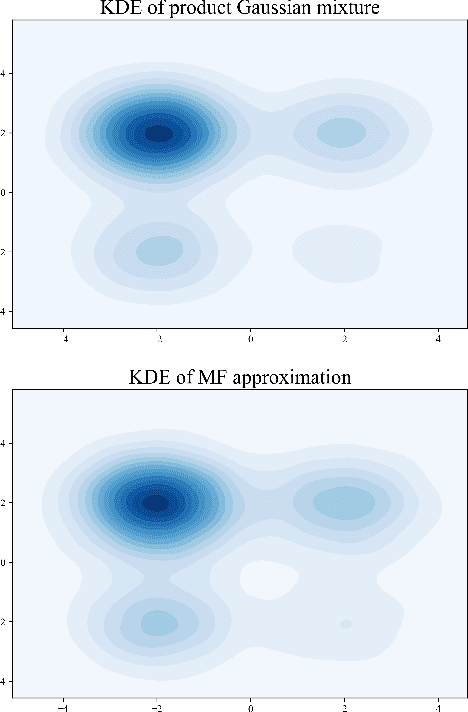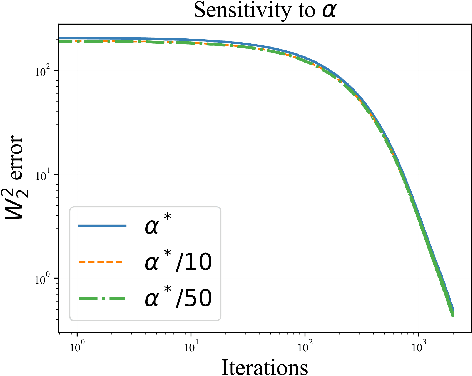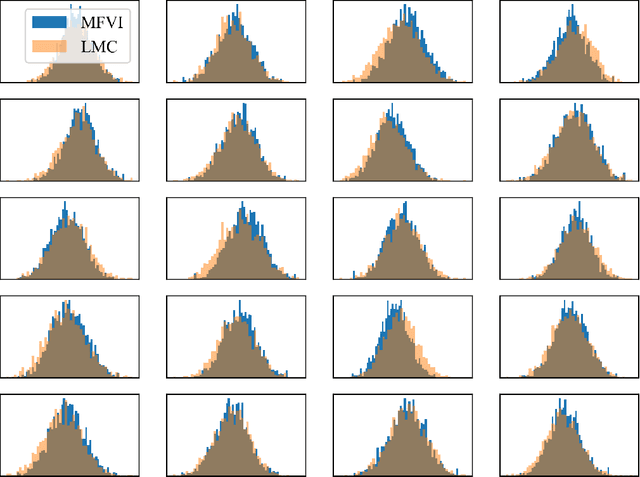Aram-Alexandre Pooladian
Conditional simulation via entropic optimal transport: Toward non-parametric estimation of conditional Brenier maps
Nov 11, 2024



Abstract:Conditional simulation is a fundamental task in statistical modeling: Generate samples from the conditionals given finitely many data points from a joint distribution. One promising approach is to construct conditional Brenier maps, where the components of the map pushforward a reference distribution to conditionals of the target. While many estimators exist, few, if any, come with statistical or algorithmic guarantees. To this end, we propose a non-parametric estimator for conditional Brenier maps based on the computational scalability of \emph{entropic} optimal transport. Our estimator leverages a result of Carlier et al. (2010), which shows that optimal transport maps under a rescaled quadratic cost asymptotically converge to conditional Brenier maps; our estimator is precisely the entropic analogues of these converging maps. We provide heuristic justifications for choosing the scaling parameter in the cost as a function of the number of samples by fully characterizing the Gaussian setting. We conclude by comparing the performance of the estimator to other machine learning and non-parametric approaches on benchmark datasets and Bayesian inference problems.
Wasserstein Flow Matching: Generative modeling over families of distributions
Nov 01, 2024



Abstract:Generative modeling typically concerns the transport of a single source distribution to a single target distribution by learning (i.e., regressing onto) simple probability flows. However, in modern data-driven fields such as computer graphics and single-cell genomics, samples (say, point-clouds) from datasets can themselves be viewed as distributions (as, say, discrete measures). In these settings, the standard generative modeling paradigm of flow matching would ignore the relevant geometry of the samples. To remedy this, we propose \emph{Wasserstein flow matching} (WFM), which appropriately lifts flow matching onto families of distributions by appealing to the Riemannian nature of the Wasserstein geometry. Our algorithm leverages theoretical and computational advances in (entropic) optimal transport, as well as the attention mechanism in our neural network architecture. We present two novel algorithmic contributions. First, we demonstrate how to perform generative modeling over Gaussian distributions, where we generate representations of granular cell states from single-cell genomics data. Secondly, we show that WFM can learn flows between high-dimensional and variable sized point-clouds and synthesize cellular microenvironments from spatial transcriptomics datasets. Code is available at [WassersteinFlowMatching](https://github.com/DoronHav/WassersteinFlowMatching).
Plug-in estimation of Schrödinger bridges
Aug 21, 2024Abstract:We propose a procedure for estimating the Schr\"odinger bridge between two probability distributions. Unlike existing approaches, our method does not require iteratively simulating forward and backward diffusions or training neural networks to fit unknown drifts. Instead, we show that the potentials obtained from solving the static entropic optimal transport problem between the source and target samples can be modified to yield a natural plug-in estimator of the time-dependent drift that defines the bridge between two measures. Under minimal assumptions, we show that our proposal, which we call the \emph{Sinkhorn bridge}, provably estimates the Schr\"odinger bridge with a rate of convergence that depends on the intrinsic dimensionality of the target measure. Our approach combines results from the areas of sampling, and theoretical and statistical entropic optimal transport.
Progressive Entropic Optimal Transport Solvers
Jun 07, 2024Abstract:Optimal transport (OT) has profoundly impacted machine learning by providing theoretical and computational tools to realign datasets. In this context, given two large point clouds of sizes $n$ and $m$ in $\mathbb{R}^d$, entropic OT (EOT) solvers have emerged as the most reliable tool to either solve the Kantorovich problem and output a $n\times m$ coupling matrix, or to solve the Monge problem and learn a vector-valued push-forward map. While the robustness of EOT couplings/maps makes them a go-to choice in practical applications, EOT solvers remain difficult to tune because of a small but influential set of hyperparameters, notably the omnipresent entropic regularization strength $\varepsilon$. Setting $\varepsilon$ can be difficult, as it simultaneously impacts various performance metrics, such as compute speed, statistical performance, generalization, and bias. In this work, we propose a new class of EOT solvers (ProgOT), that can estimate both plans and transport maps. We take advantage of several opportunities to optimize the computation of EOT solutions by dividing mass displacement using a time discretization, borrowing inspiration from dynamic OT formulations, and conquering each of these steps using EOT with properly scheduled parameters. We provide experimental evidence demonstrating that ProgOT is a faster and more robust alternative to standard solvers when computing couplings at large scales, even outperforming neural network-based approaches. We also prove statistical consistency of our approach for estimating optimal transport maps.
Neural Optimal Transport with Lagrangian Costs
Jun 01, 2024Abstract:We investigate the optimal transport problem between probability measures when the underlying cost function is understood to satisfy a least action principle, also known as a Lagrangian cost. These generalizations are useful when connecting observations from a physical system where the transport dynamics are influenced by the geometry of the system, such as obstacles (e.g., incorporating barrier functions in the Lagrangian), and allows practitioners to incorporate a priori knowledge of the underlying system such as non-Euclidean geometries (e.g., paths must be circular). Our contributions are of computational interest, where we demonstrate the ability to efficiently compute geodesics and amortize spline-based paths, which has not been done before, even in low dimensional problems. Unlike prior work, we also output the resulting Lagrangian optimal transport map without requiring an ODE solver. We demonstrate the effectiveness of our formulation on low-dimensional examples taken from prior work. The source code to reproduce our experiments is available at https://github.com/facebookresearch/lagrangian-ot.
Algorithms for mean-field variational inference via polyhedral optimization in the Wasserstein space
Dec 05, 2023


Abstract:We develop a theory of finite-dimensional polyhedral subsets over the Wasserstein space and optimization of functionals over them via first-order methods. Our main application is to the problem of mean-field variational inference, which seeks to approximate a distribution $\pi$ over $\mathbb{R}^d$ by a product measure $\pi^\star$. When $\pi$ is strongly log-concave and log-smooth, we provide (1) approximation rates certifying that $\pi^\star$ is close to the minimizer $\pi^\star_\diamond$ of the KL divergence over a \emph{polyhedral} set $\mathcal{P}_\diamond$, and (2) an algorithm for minimizing $\text{KL}(\cdot\|\pi)$ over $\mathcal{P}_\diamond$ with accelerated complexity $O(\sqrt \kappa \log(\kappa d/\varepsilon^2))$, where $\kappa$ is the condition number of $\pi$.
Learning Costs for Structured Monge Displacements
Jun 20, 2023



Abstract:Optimal transport theory has provided machine learning with several tools to infer a push-forward map between densities from samples. While this theory has recently seen tremendous methodological developments in machine learning, its practical implementation remains notoriously difficult, because it is plagued by both computational and statistical challenges. Because of such difficulties, existing approaches rarely depart from the default choice of estimating such maps with the simple squared-Euclidean distance as the ground cost, $c(x,y)=\|x-y\|^2_2$. We follow a different path in this work, with the motivation of \emph{learning} a suitable cost structure to encourage maps to transport points along engineered features. We extend the recently proposed Monge-Bregman-Occam pipeline~\citep{cuturi2023monge}, that rests on an alternative cost formulation that is also cost-invariant $c(x,y)=h(x-y)$, but which adopts a more general form as $h=\tfrac12 \ell_2^2+\tau$, where $\tau$ is an appropriately chosen regularizer. We first propose a method that builds upon proximal gradient descent to generate ground truth transports for such structured costs, using the notion of $h$-transforms and $h$-concave potentials. We show more generally that such a method can be extended to compute $h$-transforms for entropic potentials. We study a regularizer that promotes transport displacements in low-dimensional spaces, and propose to learn such a basis change using Riemannian gradient descent on the Stiefel manifold. We show that these changes lead to estimators that are more robust and easier to interpret.
Multisample Flow Matching: Straightening Flows with Minibatch Couplings
Apr 28, 2023Abstract:Simulation-free methods for training continuous-time generative models construct probability paths that go between noise distributions and individual data samples. Recent works, such as Flow Matching, derived paths that are optimal for each data sample. However, these algorithms rely on independent data and noise samples, and do not exploit underlying structure in the data distribution for constructing probability paths. We propose Multisample Flow Matching, a more general framework that uses non-trivial couplings between data and noise samples while satisfying the correct marginal constraints. At very small overhead costs, this generalization allows us to (i) reduce gradient variance during training, (ii) obtain straighter flows for the learned vector field, which allows us to generate high-quality samples using fewer function evaluations, and (iii) obtain transport maps with lower cost in high dimensions, which has applications beyond generative modeling. Importantly, we do so in a completely simulation-free manner with a simple minimization objective. We show that our proposed methods improve sample consistency on downsampled ImageNet data sets, and lead to better low-cost sample generation.
An Explicit Expansion of the Kullback-Leibler Divergence along its Fisher-Rao Gradient Flow
Feb 23, 2023


Abstract:Let $V_* : \mathbb{R}^d \to \mathbb{R}$ be some (possibly non-convex) potential function, and consider the probability measure $\pi \propto e^{-V_*}$. When $\pi$ exhibits multiple modes, it is known that sampling techniques based on Wasserstein gradient flows of the Kullback-Leibler (KL) divergence (e.g. Langevin Monte Carlo) suffer poorly in the rate of convergence, where the dynamics are unable to easily traverse between modes. In stark contrast, the work of Lu et al. (2019; 2022) has shown that the gradient flow of the KL with respect to the Fisher-Rao (FR) geometry exhibits a convergence rate to $\pi$ is that \textit{independent} of the potential function. In this short note, we complement these existing results in the literature by providing an explicit expansion of $\text{KL}(\rho_t^{\text{FR}}\|\pi)$ in terms of $e^{-t}$, where $(\rho_t^{\text{FR}})_{t\geq 0}$ is the FR gradient flow of the KL divergence. In turn, we are able to provide a clean asymptotic convergence rate, where the burn-in time is guaranteed to be finite. Our proof is based on observing a similarity between FR gradient flows and simulated annealing with linear scaling, and facts about cumulant generating functions. We conclude with simple synthetic experiments that demonstrate our theoretical findings are indeed tight. Based on our numerics, we conjecture that the asymptotic rates of convergence for Wasserstein-Fisher-Rao gradient flows are possibly related to this expansion in some cases.
Minimax estimation of discontinuous optimal transport maps: The semi-discrete case
Jan 26, 2023Abstract:We consider the problem of estimating the optimal transport map between two probability distributions, $P$ and $Q$ in $\mathbb R^d$, on the basis of i.i.d. samples. All existing statistical analyses of this problem require the assumption that the transport map is Lipschitz, a strong requirement that, in particular, excludes any examples where the transport map is discontinuous. As a first step towards developing estimation procedures for discontinuous maps, we consider the important special case where the data distribution $Q$ is a discrete measure supported on a finite number of points in $\mathbb R^d$. We study a computationally efficient estimator initially proposed by Pooladian and Niles-Weed (2021), based on entropic optimal transport, and show in the semi-discrete setting that it converges at the minimax-optimal rate $n^{-1/2}$, independent of dimension. Other standard map estimation techniques both lack finite-sample guarantees in this setting and provably suffer from the curse of dimensionality. We confirm these results in numerical experiments, and provide experiments for other settings, not covered by our theory, which indicate that the entropic estimator is a promising methodology for other discontinuous transport map estimation problems.
 Add to Chrome
Add to Chrome Add to Firefox
Add to Firefox Add to Edge
Add to Edge